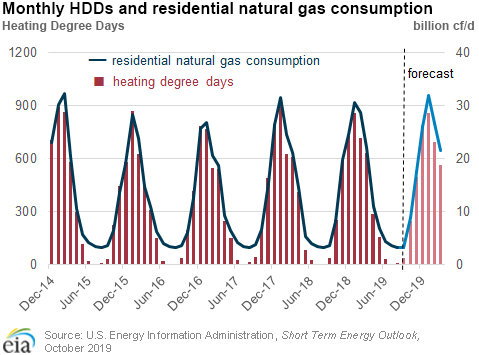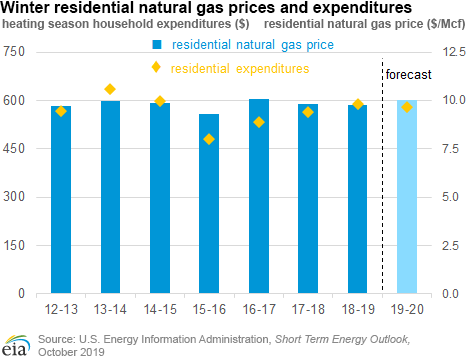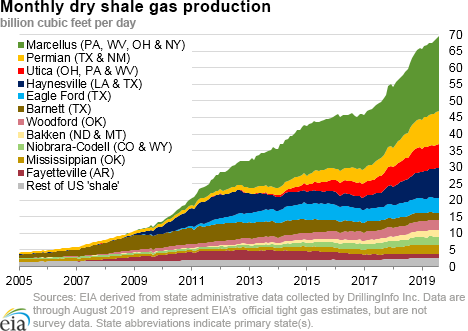In the News:
EIA’s Winter Fuels Outlook forecasts lower natural gas expenditures for households than last winter
In the 2019 Winter Fuels Outlook, released on October 8, the U.S. Energy Information Administration (EIA) forecasts expenditures for residential space heating with natural gas to be 1% (about $8) lower during winter 2019‒20 (October to March) than last year but 5% higher than the five-year average. Residential natural gas expenditures are a result of both the volume of natural gas consumed in households during the winter and the price of delivered natural gas.
The estimated expenditures this winter, about $580 per household on average, are lower primarily because expected demand for space heating is lower than last year. The National Oceanic and Atmospheric Administration (NOAA) expects temperatures for this coming winter to be warmer than last winter, forecasting 4% fewer heating degree days (HDDs) across the United States.
In the residential sector, because natural gas demand closely follows heating demand and expenditures are tied to consumption, the weather is a key factor in EIA’s forecasts of residential natural gas demand and expenditures. Excluding year-round natural gas consumption for water heating, cooking, and (in some households) clothes drying, most incremental residential consumption is for space heating. So, in the summer months, natural gas consumption remains at a relatively low, flat level. All growth outside of the baseline, year-round end uses is the result of heating demand.
The forecasted decline in heating demand associated with lower heating degree days is expected to offset higher delivered residential natural gas prices in most regions of the United States. EIA forecasts the U.S. average residential natural gas price to be $10.03 per thousand cubic feet (Mcf) this winter, up from $9.76/Mcf last winter. Prices across the country are also highly variable, reflecting both regional supply/demand dynamics and infrastructure constraints. EIA forecasts residential natural gas prices to rise by 3% in the West, 5% in the South, and 8% in the Midwest regions, but to decline by 6% in the Northeast as new infrastructure allows more natural gas to be transported throughout the region, reducing transportation delivery costs.
EIA expects wholesale natural gas prices to be 24% lower this winter, with spot prices at Henry Hub averaging $2.66/Mcf, because of strong production growth and natural gas storage inventory levels that are higher than the five-year average. However, changes in natural gas spot prices do not pass through to residential customers immediately.
Overview:
(For the week ending Wednesday, October 9, 2019)
- Natural gas spot price movements were mixed this report week (Wednesday, October 2 to Wednesday, October 9). Henry Hub spot prices fell from $2.30 per million British thermal units (MMBtu) last Wednesday to $2.22/MMBtu yesterday.
- At the New York Mercantile Exchange (Nymex), the price of the November 2019 contract decreased 1¢, from $2.247/MMBtu last Wednesday to $2.234/MMBtu yesterday. The price of the 12-month strip averaging November 2019 through October 2020 futures contracts declined 2¢/MMBtu to $2.368/MMBtu.
- Net injections to working gas totaled 98 billion cubic feet (Bcf) for the week ending October 4. Working natural gas stocks are 3,415 Bcf, which is 16% more than the year-ago level and equal to the five-year (2014–18) average for this week.
- The natural gas plant liquids composite price at Mont Belvieu, Texas, rose by 3¢/MMBtu, averaging $5.12/MMBtu for the week ending October 9. The price of natural gasoline, propane, and isobutane fell by 1%, 1%, and 3%, respectively. The price of ethane and butane rose by 6% and 8%, respectively.
- According to Baker Hughes, for the week ending Tuesday, October 1, the natural gas rig count decreased by 2 to 144. The number of oil-directed rigs fell by 3 to 710. The total rig count decreased by 5, and it now stands at 855.
Prices/Supply/Demand:
Prices are mixed across regional markets. This report week (Wednesday, October 2 to Wednesday, October 9), Henry Hub spot prices fell 8¢ from a high of $2.30/MMBtu last Wednesday to a low of $2.22/MMBtu yesterday. With the exception of Texas and in the Southeast, temperatures across most of the Lower 48 states were cooler-than-normal. At the Chicago Citygate, prices decreased 17¢ from $1.91/MMBtu last Wednesday to $1.74/MMBtu yesterday.
California prices are elevated as PG&E power outages occur. Prices at SoCal Citygate increased 30¢ from $3.28/MMBtu last Wednesday to $3.58/MMBtu yesterday. Prices at Pacific Gas & Electric (PG&E) Citygate in Northern California rose 17¢, up from $3.08/MMBtu last Wednesday to $3.25/MMBtu yesterday. Prices traded within a 29¢ range during the report week, reaching a high of $3.30/MMBtu on Tuesday.
On Monday, PG&E, the utility that serves natural gas and electricity to approximately 16 million customers in northern and central California, declared a public safety power shutoff amid peak wildfire risk. PG&E preemptively began shutting off power on Wednesday to nearly 800,000 customers in three waves, affecting a potential 34 counties in the PG&E service region. According to Genscape, flows on PG&E’s Redwood Path natural gas pipeline were 2.1 Bcf/d in the weeks before the shutoff and are down by 0.5 Bcf/d with demand destruction and a planned maintenance event. Prices at Sumas on the Canada-Washington border rose 90¢ from $3.15/MMBtu last Wednesday to $4.05/MMBtu yesterday, after reaching a high of $4.94/MMBtu on Tuesday.
Northeast prices are mixed after reaching annual lows on Friday. At the Algonquin Citygate, which serves Boston-area consumers, prices went down 16¢ from $1.92/MMBtu last Wednesday to $1.76/MMBtu yesterday. At the Transcontinental Pipeline Zone 6 trading point for New York City, prices increased 7¢ from $1.50/MMBtu last Wednesday to $1.57/MMBtu yesterday. Prices in Boston and New York hit the lowest prices of the year—81¢/MMBtu and 68¢/MMBtu, respectively—on Friday amid low demand, but rebounded on Monday as cooler temperatures increased heating demand and a force majeure on the Columbia Gas pipeline, which has reduced flows at the Rockville interconnect in Maryland by nearly 0.1 Bcf/d until further notice.
Tennessee Zone 4 Marcellus spot prices increased 12¢ from $1.34/MMBtu last Wednesday to $1.46/MMBtu yesterday. Prices at Dominion South in southwest Pennsylvania fell 2¢ from $1.42/MMBtu last Wednesday to $1.40/MMBtu yesterday.
Permian Basin prices fall amid PG&E outage. Prices at the Waha Hub in West Texas, which is located near Permian Basin production activities, averaged a high of $1.37/MMBtu last Wednesday, 93¢/MMBtu lower than Henry Hub prices. Yesterday, prices at the Waha Hub averaged $0.92/MMBtu, $1.30/MMBtu lower than Henry Hub prices, as takeaway capacity into markets in northern and central California was limited.
Supply is down. According to data from IHS Markit, the average total supply of natural gas fell by 1% compared with the previous report week. Dry natural gas production remained constant week over week. Average net imports from Canada decreased by 3% from last week.
Demand falls driven by power generation sector. Total U.S. consumption of natural gas fell by 3% compared with the previous report week, according to data from IHS Markit. Natural gas consumed for power generation declined by 6% week over week because of overall lower cooling demand. Industrial sector consumption decreased by 1% week over week. In the residential and commercial sectors, consumption declined by 1%. Natural gas exports to Mexico were the same as last week, averaging 5.4 Bcf/d.
U.S. LNG exports are flat week over week. Eleven LNG vessels (seven from Sabine Pass, three from Corpus Christi, and one from Freeport LNG export terminals) with a combined LNG-carrying capacity of 41 Bcf departed the United States between October 3 and October 9, according to shipping data compiled by Bloomberg. One vessel was loading at the Sabine Pass LNG terminal on Wednesday.
Elba Island LNG became the sixth U.S. LNG liquefaction export facility to begin LNG production. Elba Island LNG consists of 10 small Moveable Modular Liquefaction System (MMLS) units, each with a capacity of 0.03 Bcf/d. On September 30, Federal Energy Regulatory Commission authorized the Elba Liquefaction Company, L.L.C. and Southern LNG Company, L.L.C. (the developers of Elba Island liquefaction facility) to place the first of 10 liquefaction units into commercial service. Elba Island liquefaction facility is located at the site of an existing regasification terminal near Savannah, Georgia.
Storage:
Net injections into storage totaled 98 Bcf for the week ending October 4, compared with the five-year (2014–18) average net injections of 89 Bcf and last year's net injections of 91 Bcf during the same week. Working gas stocks totaled 3,415 Bcf, which is 9 Bcf lower than the five-year average and 472 Bcf more than last year at this time.
According to The Desk survey of natural gas analysts, estimates of the weekly net change from working natural gas stocks ranged from net injections of 80 Bcf to 105 Bcf, with a median estimate of 97 Bcf.
The average rate of net injections into storage is 27% higher than the five-year average so far in the refill season (April through October). If the rate of injections into storage matched the five-year average of 9.9 Bcf/d for the remainder of the refill season, total inventories would be 3,683 Bcf on October 31, which is 9 Bcf lower than the five-year average of 3,692 Bcf for that time of year.
More storage data and analysis can be found on the Natural Gas Storage Dashboard and the Weekly Natural Gas Storage Report.
See also:
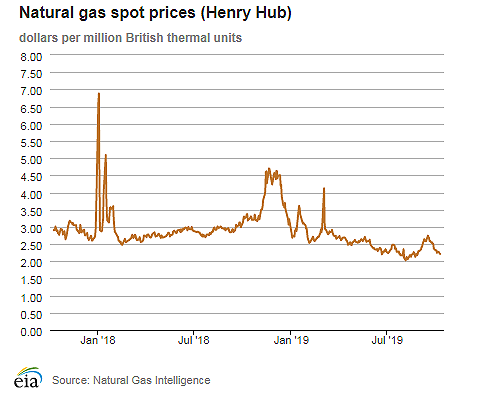
| Spot Prices ($/MMBtu) | Thu, 03-Oct |
Fri, 04-Oct |
Mon, 07-Oct |
Tue, 08-Oct |
Wed, 09-Oct |
|---|---|---|---|---|---|
| Henry Hub |
2.25 |
2.29 |
2.26 |
2.23 |
2.22 |
| New York |
1.14 |
0.68 |
1.17 |
1.26 |
1.57 |
| Chicago |
1.84 |
1.64 |
1.64 |
1.71 |
1.74 |
| Cal. Comp. Avg.* |
2.50 |
2.52 |
2.97 |
3.17 |
2.79 |
| Futures ($/MMBtu) | |||||
| November contract | 2.329 |
2.352 |
2.303 |
2.288 |
2.234 |
| December contract |
2.500 |
2.524 |
2.500 |
2.491 |
2.436 |
| *Avg. of NGI's reported prices for: Malin, PG&E Citygate, and Southern California Border Avg. | |||||
| Source: NGI's Daily Gas Price Index | |||||
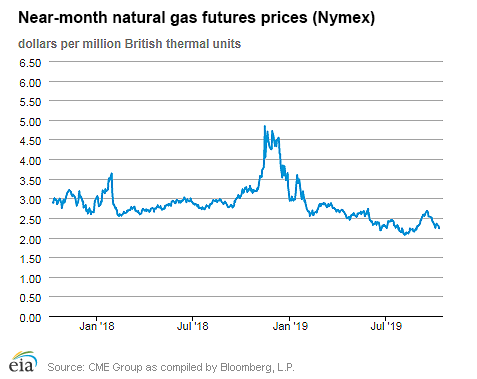
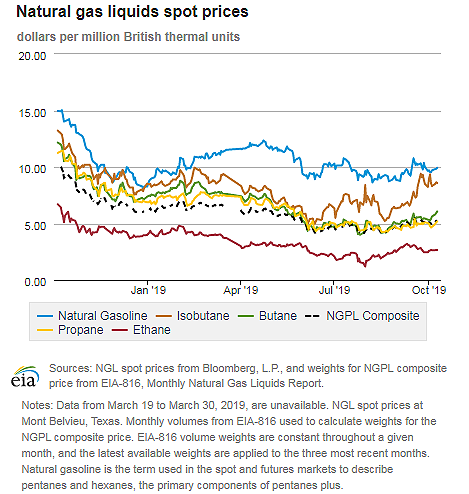
| U.S. natural gas supply - Gas Week: (10/3/19 - 10/9/19) | |||
|---|---|---|---|
Average daily values (Bcf/d): |
|||
this week |
last week |
last year |
|
| Marketed production | 105.6 |
106.3 |
97.7 |
| Dry production | 93.5 |
94.0 |
86.7 |
| Net Canada imports | 4.5 |
4.6 |
5.4 |
| LNG pipeline deliveries | 0.1 |
0.1 |
0.1 |
| Total supply | 98.1 |
98.7 |
92.1 |
|
Source: IHS Markit | |||
| U.S. natural gas consumption - Gas Week: (10/3/19 - 10/9/19) | |||
|---|---|---|---|
Average daily values (Bcf/d): |
|||
this week |
last week |
last year |
|
| U.S. consumption | 63.7 |
65.9 |
66.6 |
| Power | 32.4 |
34.4 |
33.2 |
| Industrial | 21.1 |
21.2 |
21.2 |
| Residential/commercial | 10.3 |
10.3 |
12.2 |
| Mexico exports | 5.4 |
5.4 |
5.0 |
| Pipeline fuel use/losses | 6.3 |
6.4 |
6.1 |
| LNG pipeline receipts | 6.1 |
6.3 |
2.9 |
| Total demand | 81.5 |
84.1 |
80.6 |
|
Source: IHS Markit | |||
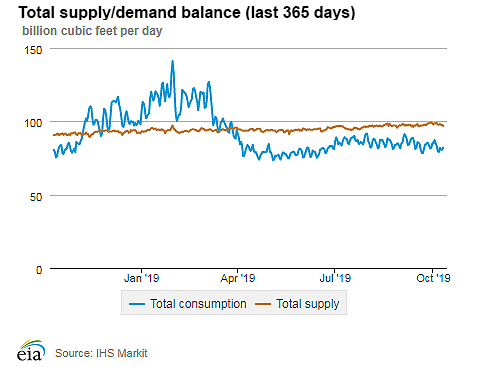
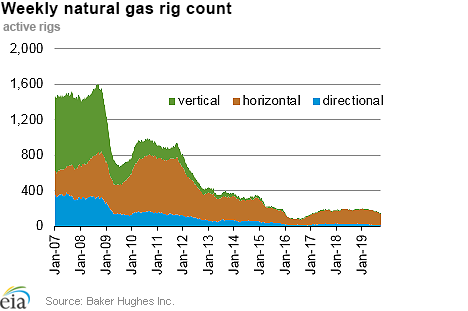
| Rigs | |||
|---|---|---|---|
Tue, October 01, 2019 |
Change from |
||
last week |
last year |
||
| Oil rigs | 710 |
-0.4% |
-17.5% |
| Natural gas rigs | 144 |
-1.4% |
-23.8% |
| Note: Excludes any miscellaneous rigs | |||
| Rig numbers by type | |||
|---|---|---|---|
Tue, October 01, 2019 |
Change from |
||
last week |
last year |
||
| Vertical | 52 |
2.0% |
-22.4% |
| Horizontal | 749 |
-0.4% |
-18.5% |
| Directional | 54 |
-5.3% |
-18.2% |
| Source: Baker Hughes Inc. | |||
| Working gas in underground storage | ||||
|---|---|---|---|---|
Stocks billion cubic feet (Bcf) |
||||
| Region | 2019-10-04 |
2019-09-27 |
change |
|
| East | 854 |
826 |
28 |
|
| Midwest | 1,009 |
973 |
36 |
|
| Mountain | 203 |
199 |
4 |
|
| Pacific | 296 |
291 |
5 |
|
| South Central | 1,054 |
1,029 |
25 |
|
| Total | 3,415 |
3,317 |
98 |
|
|
Source: Form EIA-912, Weekly Underground Natural Gas Storage Report | ||||
| Working gas in underground storage | |||||
|---|---|---|---|---|---|
Historical comparisons |
|||||
Year ago (10/4/18) |
5-year average (2014-2018) |
||||
| Region | Stocks (Bcf) |
% change |
Stocks (Bcf) |
% change |
|
| East | 786 |
8.7 |
852 |
0.2 |
|
| Midwest | 866 |
16.5 |
977 |
3.3 |
|
| Mountain | 180 |
12.8 |
205 |
-1.0 |
|
| Pacific | 262 |
13.0 |
316 |
-6.3 |
|
| South Central | 850 |
24.0 |
1,074 |
-1.9 |
|
| Total | 2,943 |
16.0 |
3,424 |
-0.3 |
|
| Source: Form EIA-912, Weekly Underground Natural Gas Storage Report | |||||
| Temperature – heating & cooling degree days (week ending Oct 03) | ||||||||
|---|---|---|---|---|---|---|---|---|
HDD deviation from: |
CDD deviation from: |
|||||||
| Region | HDD Current |
normal |
last year |
CDD Current |
normal |
last year |
||
| New England | 36 |
-28 |
-11 |
5 |
4 |
5 |
||
| Middle Atlantic | 13 |
-39 |
-8 |
20 |
16 |
16 |
||
| E N Central | 16 |
-39 |
-34 |
35 |
30 |
25 |
||
| W N Central | 44 |
-10 |
-28 |
31 |
23 |
19 |
||
| South Atlantic | 0 |
-23 |
0 |
98 |
55 |
24 |
||
| E S Central | 0 |
-22 |
-4 |
106 |
78 |
47 |
||
| W S Central | 0 |
-6 |
-3 |
117 |
63 |
46 |
||
| Mountain | 60 |
2 |
25 |
18 |
-7 |
-16 |
||
| Pacific | 45 |
26 |
38 |
1 |
-17 |
-22 |
||
| United States | 23 |
-16 |
-4 |
50 |
28 |
16 |
||
|
Note: HDD = heating degree day; CDD = cooling degree day Source: National Oceanic and Atmospheric Administration | ||||||||
Average temperature (°F)
7-day mean ending Oct 03, 2019
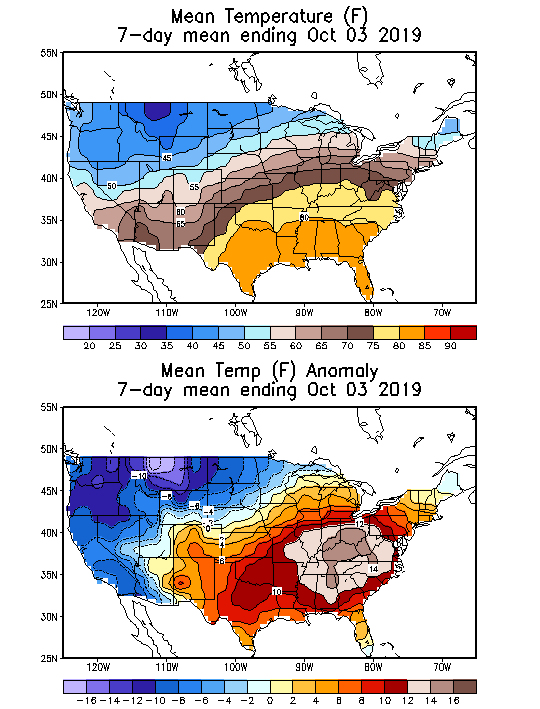
Source: National Oceanic and Atmospheric Administration
Deviation between average and normal (°F)
7-day mean ending Oct 03, 2019

Source: National Oceanic and Atmospheric Administration

